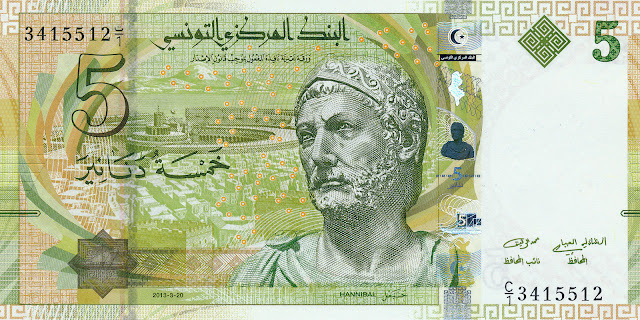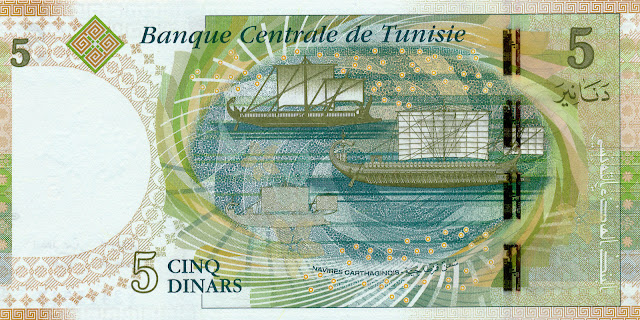Tunisia Banknotes 5 Dinars banknote 2013 Hannibal
Central Bank of Tunisia - Banque Centrale de Tunisie
Obverse: Tunisia new 5-dinar note embraces Tunisia's Carthaginian past, with an image of Hannibal wearing a helmet (A marble bust, reputedly of Hannibal, originally found at the ancient city-state of Capua in Italy) - the Carthaginian army general and statesman (247-183 B.C.). Phoenician (Punic) military port and the Port Punique in Carthage. The ancient empire of Carthage was based near the modern capital city of Tunis. Holographic stripe with Hannibal, Carthaginian ship, and crescent moon and star. Windowed green-to-gold security thread with demetalized design.
Reverse: Carthaginian ships.
Watermark: Olive tree and electrotype 5.
Original Size: 143 x 73 mm.
The 5 Dinar bill will replace the old five dinar banknotes, which featured a different image of Hannibal on the front and a depiction of the date Bel Ali took power, November 7, 1987, on the back. This imagery was a feature on all Ben Ali-era banknotes. Since the revolution, the 50, 20, and 10 dinar bills have been replaced with new designs. The decision to remove the Ben Ali notes from circulation was made in February 2011, shortly after the autocrat was forced from office.
Tunisia Banknotes - Tunisia Paper Money
2008-2013 Issue
Hannibal
Hannibal Barca, son of Hamilcar Barca (247 – 183/182/181 BC) was a Punic Carthaginian military commander, generally considered one of the greatest military commanders in history. His father, Hamilcar Barca, was the leading Carthaginian commander during the First Punic War, his younger brothers were Mago and Hasdrubal, and he was brother-in-law to Hasdrubal the Fair.
Hannibal lived during a period of great tension in the Mediterranean, when the Roman Republic established its supremacy over other great powers such as Carthage and the Hellenistic kingdoms of Macedon, Syracuse, and the Seleucid Empire. One of his most famous achievements was at the outbreak of the Second Punic War, when he marched an army, which included elephants, from Iberia over the Pyrenees and the Alps into Italy. In his first few years in Italy, he won three dramatic victories — Trebia, Trasimene, and Cannae, in which he distinguished himself for his ability to determine his and his opponent's strengths and weaknesses, and to play the battle to his strengths and the enemy's weaknesses — and won over many allies of Rome. Hannibal occupied much of Italy for 15 years, but a Roman counter-invasion of North Africa forced him to return to Carthage, where he was decisively defeated by Scipio Africanus at the Battle of Zama. Scipio had studied Hannibal's tactics and brilliantly devised some of his own, and finally defeated Rome's nemesis at Zama, having previously driven Hasdrubal, Hannibal's brother, out of the Iberian Peninsula.
After the war, Hannibal successfully ran for the office of suffete. He enacted political and financial reforms to enable the payment of the war indemnity imposed by Rome; however, Hannibal's reforms were unpopular with members of the Carthaginian aristocracy and in Rome, and he fled into voluntary exile. During this time, he lived at the Seleucid court, where he acted as military advisor to Antiochus III in his war against Rome. After Antiochus met defeat at the Battle of Magnesia and was forced to accept Rome's terms, Hannibal fled again, making a stop in Armenia. His flight ended in the court of Bithynia, where he achieved an outstanding naval victory against a fleet from Pergamon. He was afterwards betrayed to the Romans and committed suicide by poisoning himself.
Often regarded as one of the greatest military strategists in history, Hannibal would later be considered one of the greatest generals of antiquity, together with Alexander the Great, Julius Caesar, Scipio, and Pyrrhus of Epirus. Plutarch states that, when questioned by Scipio as to who was the greatest general, Hannibal is said to have replied either Alexander or Pyrrhus, then himself, or, according to another version of the event, Pyrrhus, Scipio, then himself. Military historian Theodore Ayrault Dodge once famously called Hannibal the "father of strategy", because his greatest enemy, Rome, came to adopt elements of his military tactics in its own strategic arsenal. This praise has earned him a strong reputation in the modern world, and he was regarded as a great strategist by men like Napoleon Bonaparte.
Carthage
The city of Carthage is a city in Tunisia that was once the centre of the ancient Carthaginian civilization. The city developed from a Phoenician colony of the 1st millennium BC into the capital of an ancient empire. The area of Carthage was before inhabited by Berber people who also became the bulk of Carthage's population and constituted a significant part of its army, economy and administration. Native Berbers and settling Phoenicians in Carthage mixed in different ways including religion and language, creating the Punic language and culture.
The name of Carthage, Latin: Carthago or Karthago, Ancient Greek: Καρχηδών Karkhēdōn, Etruscan: *Carθaza, is derived from the Phoenician Qart-ḥadašt meaning "New City" (Aramaic: קרתא חדתא Qarta Ḥdatha; Hebrew: קרת חדשה Qeret Ḥadašah), implying it was a 'new Tyre'.
The first civilization that developed within the city's sphere of influence is referred to as Punic (a form of the word "Phoenician") or Carthaginian. The city of Carthage is located on the eastern side of Lake Tunis across from the centre of Tunis. According to Greek historians, Carthage was founded by Canaanite-speaking Phoenician colonists from Tyre (in modern Lebanon) under the leadership of Queen Elissa or Dido. It became a large and rich city and thus a major power in the Mediterranean. The resulting rivalry with Syracuse, Numidia, and Rome was accompanied by several wars with respective invasions of each other's homeland.
Hannibal's invasion of Italy in the Second Punic War culminated in the Carthaginian victory at Cannae and led to a serious threat to the continuation of Roman rule over Italy; however, the Romans gained the upper hand by invading Africa and defeating Carthage at the Battle of Zama in 202 BC. Following the Third Punic War, the city was destroyed by the Romans in 146 BC. However, the Romans refounded Carthage, which became the empire's fourth most important city and the second most important city in the Latin West. It later became the capital of the short-lived Vandal kingdom. It remained one of the most important Roman cities until the Muslim conquest, when it was destroyed a second time in 698.
The ancient Greek philosopher Aristotle wrote extensively on Carthaginian politics, and he considered the city to have one of the best governing institutions in the world, along with those of the Greek states of Sparta and Crete.

